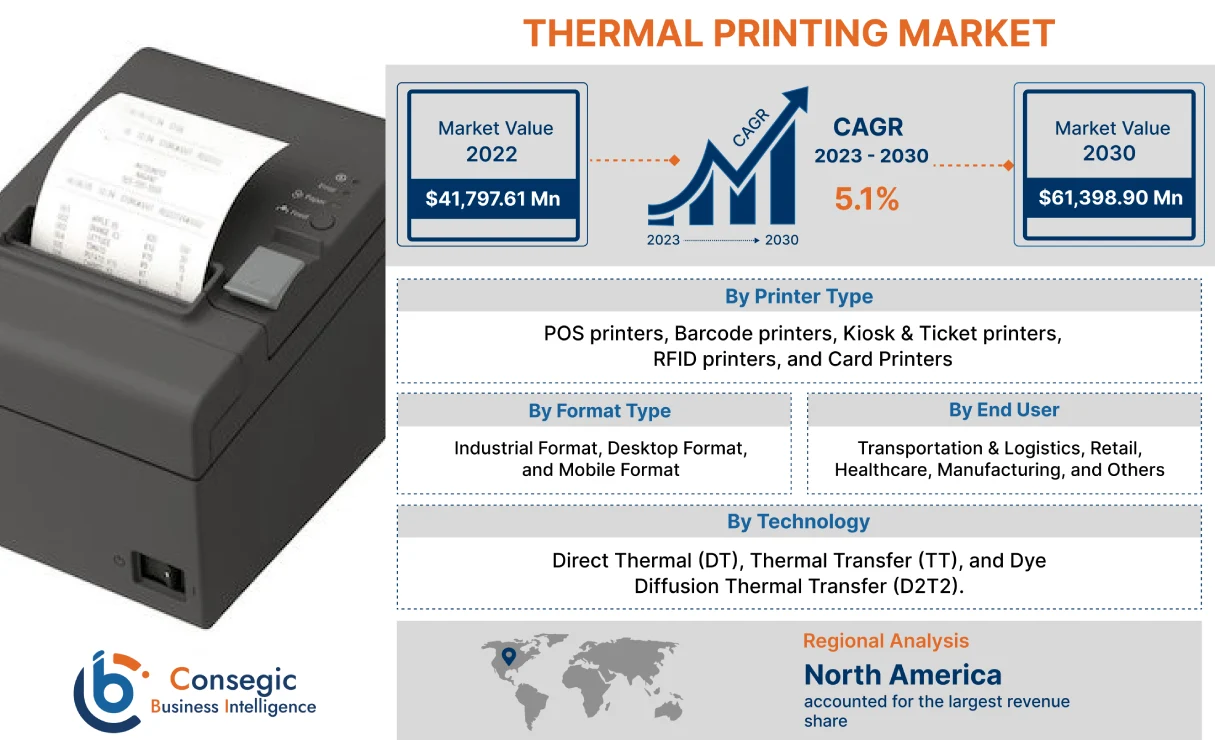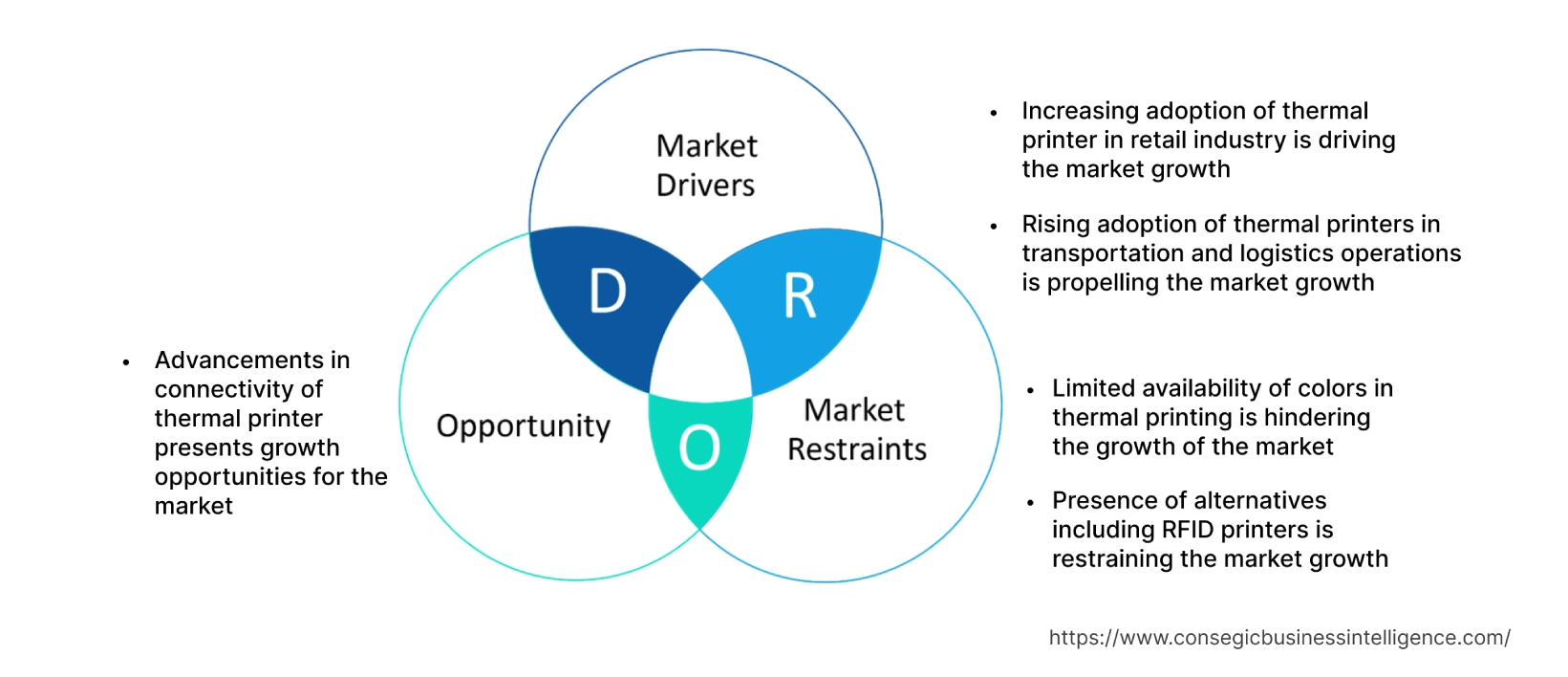- Summary
- Table Of Content
- Methodology
Thermal Printing Market Size :
Thermal Printing Market size is estimated to reach over USD 61,398.90 Million by 2030 from a value of USD 41,797.61 Million in 2022, growing at a CAGR of 5.1% from 2023 to 2030.
Thermal Printing Market Scope & Overview:
Thermal printing is a digital printing process that uses heat to transfer an image or text onto paper or other thermal media. A thermal printer produces a printed image by passing thermal paper with a thermochromic coating over a print head consisting of tiny electrically heated elements. The heat causes the layer to react and produce the desired image or text. Consequently, thermal printers are used for printing receipts, barcodes, and shipping labels, allowing for the creation of high-quality, long-lasting prints.
Thermal Printing Market Insights :
Key Drivers :
Increasing adoption of thermal printer in retail industry is driving the market growth
The increasing adoption of thermal printer in the retail sector for applications including printing receipts, price tags, product labels, and barcodes. Moreover, thermal printers are used for high-volume transactional printing due to the high speed, efficiency, and cost-effectiveness of thermal printers. Thus, retailers are focusing on improving point of sale experience by providing customers with rapid and convenient services. For instance, in May 2023, BIXOLON Europe GmbH launched thermal point-of-sale printer series called SRP-330III for receipting and ticketing operations in the sectors including retail, transportation and hospitality. Consequently, the growing adoption of thermal printers in retail industry to improve customer service and streamlining checkout process is accelerating the growth of the market.
Rising adoption of thermal printers in transportation and logistics operations is propelling the market growth
The rising adoption of thermal printers in logistics and shipping operations have increased over the years owing to growing adoption of barcode technology for airline baggage tracking and shipping packages. Major players in the logistics segment including UPS, DHL, TNT, and FedEx have raised the demand for thermal printers to streamline business operations. Moreover, thermal printers play a crucial role in labelling and re-labelling of packages and providing delivery notes or information to the consumers. For instance, in March 2023, Toshiba America Business Solutions, Inc. launched industrial duplex linerless thermal printer, DL1024 for packaging applications in shipping and logistics operations. Moreover, the durability of thermal prints ensures that important information remains intact throughout the transportation process, thereby contributing to the growth of thermal printing market.
Key Restraints :
Limited availability of colors in thermal printing is hindering the growth of the market
Thermal printing is primarily used for monochrome or grayscale printing. Direct thermal printing technology uses heat-sensitive paper instead of thermal ribbon for printing. As a result, direct thermal printers are utilized for printing in black and white colors including barcodes, receipts, and bills. Thus, the inability of thermal printers to produce variable colors is restraining the growth of the market.
Presence of alternatives including RFID printers is restraining the market growth
The availability of alternatives, including Radio Frequency Identification (RFID) printers is restraining the growth of the market. RFID printers are designed to simultaneously print and embed RFID data into RFID tags during the printing process. RFID tags are adhesive-backed print media that contain RFID chip for storing information about the product. Therefore, the increasing adoption of advanced technologies including RFID technology is hindering the growth of the market.
Future Opportunities :
Advancements in connectivity of thermal printer presents growth opportunities for the market
The advancements in connectivity options for thermal printers including Wi-Fi and Bluetooth is expected to present potential opportunities for the growth of thermal printing market during the forecast period. Thermal printers support both USB and Bluetooth connectivity options, providing flexibility and convenience in connecting to different devices including smartphones, laptops, and tablets. The integration of advanced connectivity options in thermal printers streamlines the printing workflows, facilitate remote monitoring and management, and also enables automated print tasks. Thus, the advancements in connectivity of thermal printer are expected to drive the market growth during the forecast period.
Global Thermal Printing Market Report Insights :
| Report Attributes | Report Details |
| Study Timeline | 2017-2030 |
| Market Size in 2030 | USD 61,398.90 Million |
| CAGR (2023-2030) | 5.1% |
| By Printer Type | POS printers, Barcode printers, Kiosk & Ticket printers, RFID printers, and Card Printers |
| By Format Type | Industrial Format, Desktop Format, and Mobile Format |
| By Technology | Direct Thermal (DT), Thermal Transfer (TT), and Dye Diffusion Thermal Transfer (D2T2). |
| By End-User | Transportation & Logistics, Retail, Healthcare, Manufacturing, and Others |
| By Region | North America, Europe, Asia-Pacific, Latin America, and Middle East & Africa |
| Key Players | Zebra Technologies Corporation, Sato Holdings Corporation, Honeywell International Inc., Bioxolon, Brother International Corporation, Star Micronics Co., Ltd., Toshiba Tec Corporation, TSC Auto ID Technology Co., Ltd., Avery Dennison Corporation, Xiamen Rongta Technology Co., Ltd., Fujitsu, Dascom |
| Geographies Covered | |
| North America | U.S. Canada Mexico |
| Europe | U.K. Germany France Spain Italy Russia Benelux Rest of Europe |
| APAC | China South Korea Japan India Australia ASEAN Rest of Asia-Pacific |
| Middle East and Africa | GCC Turkey South Africa Rest of MEA |
| LATAM | Brazil Argentina Chile Rest of LATAM |
| Report Coverage | Revenue Forecast, Competitive Landscape, Growth Factors, Restraint or Challenges, Opportunities, Environment & Regulatory Landscape, PESTLE Analysis, PORTER Analysis, Key Technology Landscape, Value Chain Analysis, Cost Analysis, and Regional Trends & Forecast |
Thermal Printing Market Segmental Analysis :
By Printer Type :
Based on the printer type, the market is segregated into POS printers, barcode printers, kiosk & ticket printers, RFID printers, and card printers. Barcode printers segment accounted for the largest revenue share in the year 2022. The increasing adoption of barcode technology in retail, logistics, and manufacturing industry is driving the growth of the market. Barcode printers are designed specifically for printing barcodes in industries including retail, logistics, manufacturing, and healthcare. Consequently, barcode printers are crucial for product identification, inventory management, and supply chain tracking. For instance, in April 2023, SATO Europe GmbH launched smart and intuitive 4" barcode printer called CT4-LX-HC featuring 4.3-inch color touchscreen to achieve next-level patient and consumer care in healthcare sector.
The RFID printer segment is anticipated to emerge as the fastest-growing segment during the forecast period. RFID printers are used for encoding and printing RFID tags and labels. RFID printers automate the process of data collection, thereby reducing human effort and error. As a result, RFID technology is utilized in sectors including retail, logistics, healthcare, and manufacturing for asset tracking, and supply chain optimization. Furthermore, the ability of RFID readers to scan multiple barcodes simultaneously is accelerating the growth of thermal printing market.
By Format Type :
Based on the format type, the market is trifurcated into industrial format, desktop format, and mobile format. The desktop format segment accounted for the largest revenue share in the year 2022. The cost-effectiveness, ease of use, and the ability of desktop thermal printers to offer a smaller footprint is driving the growth of the market. Desktop format thermal printers are compact and versatile printers that are suitable for small to medium-sized businesses, retail stores, offices, and healthcare settings. Desktop thermal printers have applications including printing receipts, labels, barcodes, and other essential documents. For instance, in March 2022, TSC Printronix launched series of desktop printers including TX310, TX210, and TX610 that are designed to deliver high print speeds of 6"/second, 8"/second, and 4"/second respectively for printing labels in manufacturing, transport & logistics and healthcare industry. Consequently, the increasing adoption of point-of-sale systems is propelling the growth of the market.
The mobile format segment is anticipated to witness the fastest CAGR growth during the forecast period. The lightweight, compact size, and portability of mobile thermal printers is accelerating the growth of the market. Mobile thermal printers are widely used by field service technicians, delivery drivers, healthcare professionals, and other mobile workers requiring portable printing capabilities. Consequently, the increasing demand for on-site printing of labels and documents is driving the growth of the market.
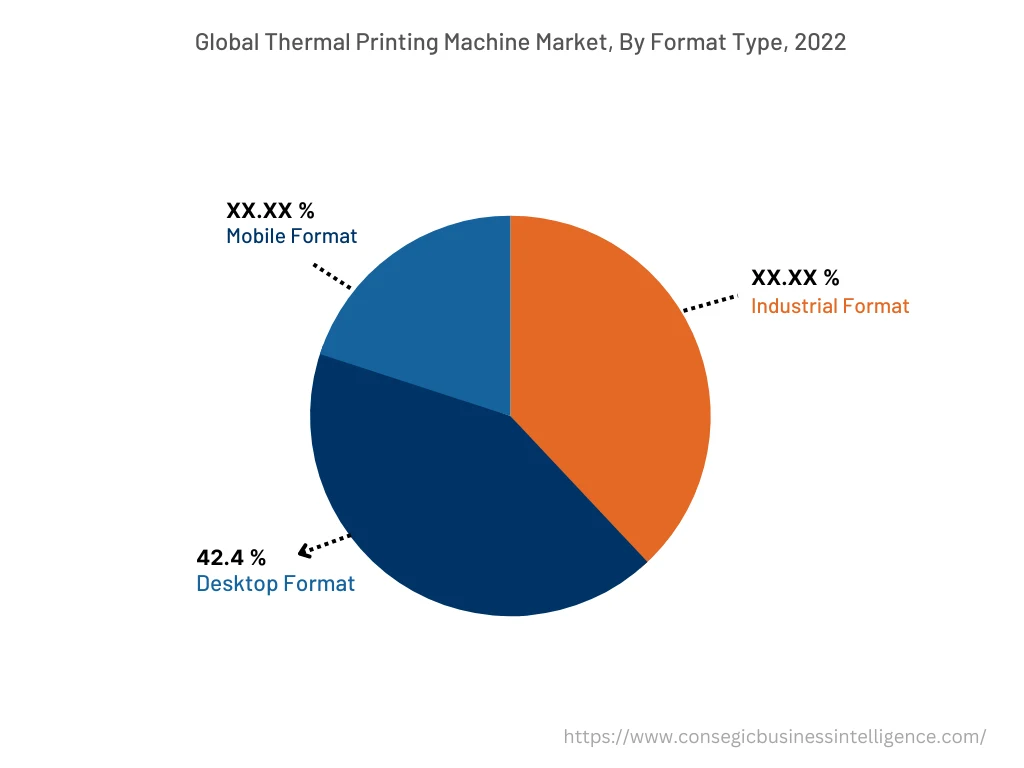
By Technology :
Based on the technology, the market is trifurcated into Direct Thermal (DT), Thermal transfer (TT), and Dye diffusion thermal transfer (D2T2). Direct thermal (DT) segment accounted for the largest revenue share in the year 2022. Direct thermal printing technology deploys heat-sensitive paper or labels to produce images without the requirement for ink or toner. The heat from the print head activates the chemicals on the thermal media, resulting in a black or grayscale print. For instance, in January 2021, Avery Dennison Corporation introduced new recycled direct thermal paper labels featuring high image resolution, high print speed, and are compatible with a wide range of printers. Therefore, the application of direct thermal technology for printing shipping labels, barcode labels, and tickets is propelling the growth of the market.
The thermal transfer segment is anticipated to register the fastest CAGR growth during the forecast period. Thermal transfer printing involves the transfer of ink from a ribbon onto the media, including labels or tags. The print head applies heat to the ribbon, melting the ink and transferring it onto the substrate. As a result, the technology offers durable and long-lasting prints that are resistant to environmental factors including heat, light, and chemicals. Thus, the rising need for high-quality prints and long-term durability in label printing is proliferating the growth of the market.
By End-User :
Based on the end-user, the market is segmented into transportation & logistics, retail, healthcare, manufacturing, and others. The retail segment accounted for the largest revenue share in the year 2022. The increasing demand for clear and accurate product labeling coupled with pricing information in retail industry is driving the growth of thermal printing market. Thermal printers offer quick transaction processing, high-quality receipts, and cost-effective printing solutions for retailers. For instance, in February 2020, Videojet Technologies Inc. launched cool black solvent thermal inkjet ink for printing high-quality codes and labels on food products, high-end cosmetics, and pharmaceuticals products. Therefore, the growing adoption of thermal printing in retail industry for applications, including point-of-sale (POS) receipts, product labels, and price tags is driving the growth of the market.
The transportation and logistics segment is anticipated to witness fastest CAGR growth during the forecast period. Thermal printing has a crucial role in the transportation and logistics sector for accurate labeling and tracking of packages. The increasing volume of e-commerce shipments has resulted in increasing demand for thermal printers to improve supply chain visibility and logistics operations. Consequently, the application of thermal printing for printing packing slips and invoices is proliferating the growth of the market.
By Region :
The regional segment includes North America, Europe, Asia Pacific, Middle East and Africa, and Latin America.
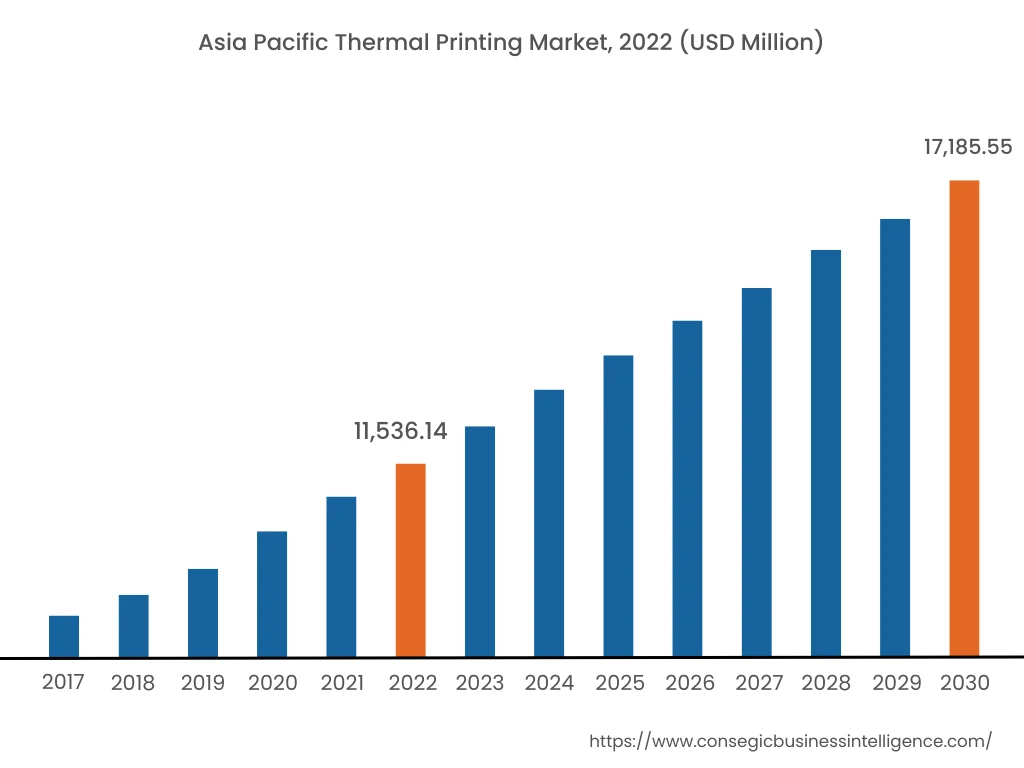
North America accounted for the largest revenue share in the year 2022. The increasing adoption of advanced thermal printing technologies including RFID technology to improve print quality is driving the growth of the market. Retailers are increasingly adopting thermal printers to produce faster printing speeds with enhanced connectivity options for efficient business operations. Moreover, the growing e-commerce industry in North America is propelling the growth of the market. For instance, in May 2021, Zebra Technologies Corporation launched first wireless label printing solution called ZSB Series printer for label printing in e-commerce operations. Thus, the rising e-commerce industry coupled with the adoption of advanced printing technologies is propelling the growth of the regional market.
Asia-Pacific region accounted for the revenue share of USD 11,536.14 million in 2022 and is expected to reach USD 17,185.55 million in 2030, registering a CAGR of 5.3% during the forecast period. Additionally, in the region, China accounted for the largest revenue share of 33.40% in the year 2022. Asia-Pacific has a strong manufacturing base for thermal printing devices and components. Manufacturers in the region are taking several initiatives to manufacture printers and supplies for retail and e-commerce industry. Moreover, rapidly growing retail industry in the Asia-Pacific region is accelerating the growth of the regional market.
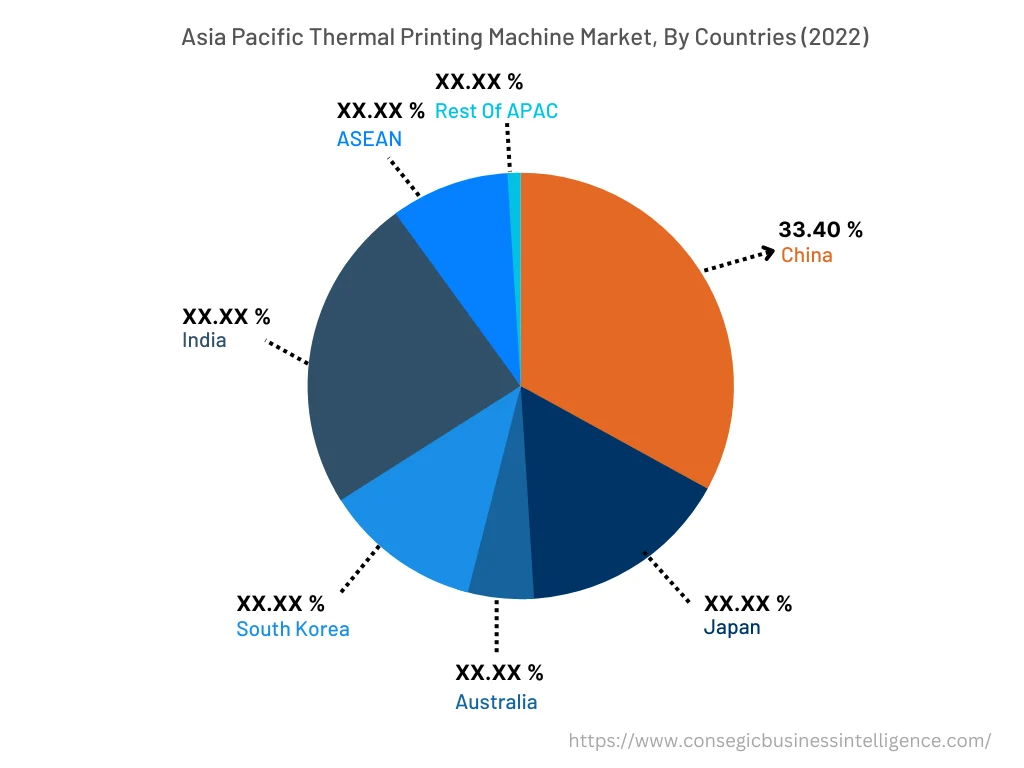
Top Key Players & Market Share Insights:
The thermal printing market is highly competitive with major players providing advanced printing technologies to the domestic and international markets. Key players are adopting several strategies in product innovation, research, and development (R&D), and various business strategies, and application launches that accelerate the growth of the thermal printing market. Key players in the market include-
- Zebra Technologies Corporation
- Sato Holdings Corporation
- Avery Dennison Corporation
- Xiamen Rongta Technology Co., Ltd.
- Fujitsu
- Dascom
- Honeywell International Inc.
- Bioxolon
- Brother International Corporation
- Star Micronics Co., Ltd.
- Toshiba Tec Corporation
- TSC Auto ID Technology Co., Ltd.
Recent Industry Developments :
- In November 2022, Loftware Inc. collaborated with SATO to launch first cloud-based RFID tag logging and encoding solution for printing barcodes on medical devices, pharmaceuticals, and luxury goods.
- In February 2023, Mimaki Engineering Co., Ltd. launched first direct-to-film (DTF) printer called TxF150-75 and heat transfer pigment ink for apparel and textile printing applications.
Key Questions Answered in the Report
What is thermal printing? +
Thermal printing is a digital printing process that uses heat in order to produce the image on paper. Thermal printing technique is used for printing labels, barcodes, and receipts.
What specific segmentation details are covered in the thermal printing report, and how is the dominating segment impacting the market growth? +
By technology segment has witnessed Direct Transfer (DT) as the dominating segment in the year 2022, due to its ability to produce images without the need for ink or toner.
What specific segmentation details are covered in the thermal printing market report, and how is the fastest segment anticipated to impact the market growth? +
By application segment has witnessed transportation and logistics as the fastest-growing segment during the forecast period due to the rapid expansion of e-commerce industry.
Which region/country is anticipated to witness the highest CAGR during the forecast period, 2023-2030? +
Asia-Pacific is expected to register fastest CAGR growth during the forecast period due to the large manufacturing base in Asia-Pacific region.
